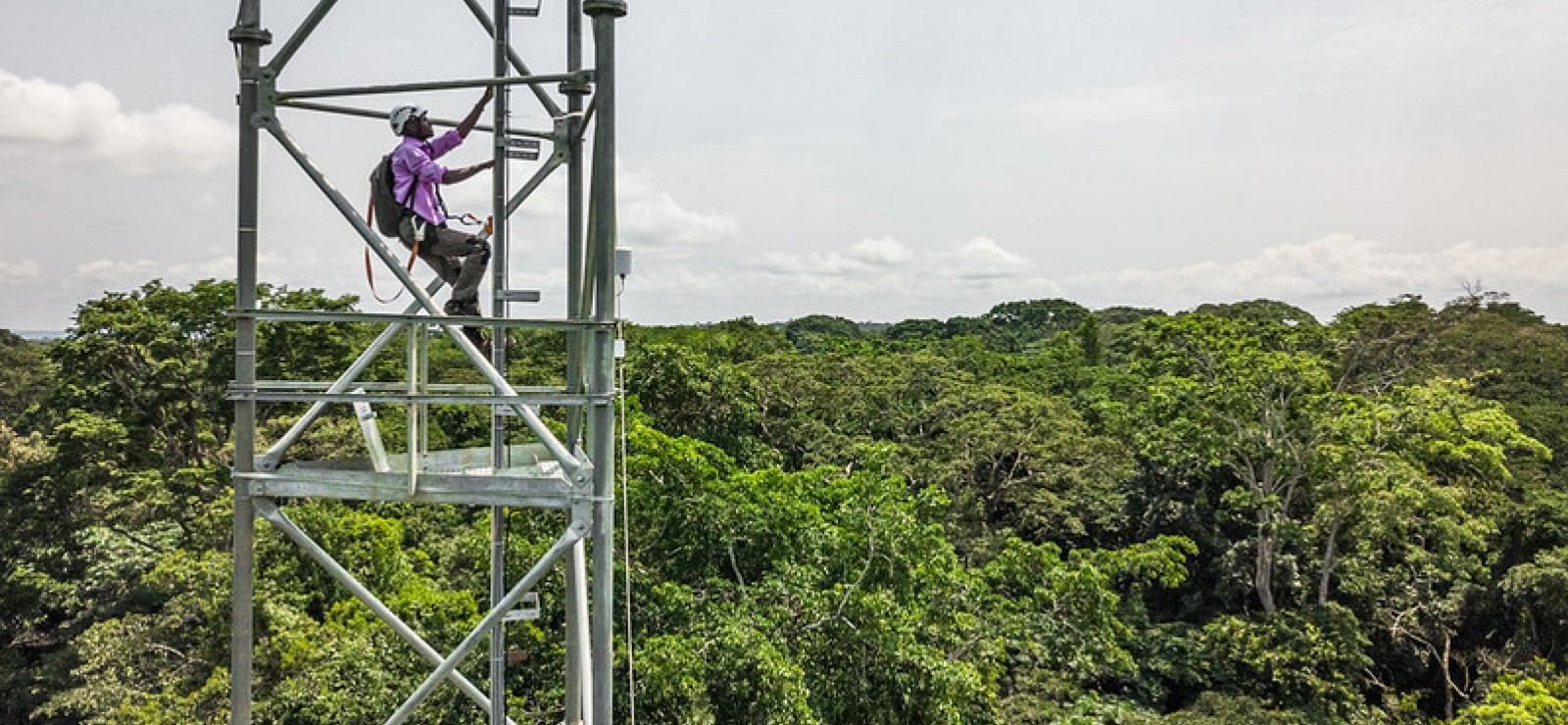Deep in the Congolese rainforest there’s a 57-metre-high tower helping in the study of climate change. Since October 2020, the Ghent University climate tower has been measuring both how much CO₂ the tropical forest stores, and how much water evaporates. “In that part of the world, it is unique,” says professor Pascal Boeckx. “Plans for a second tower have already started.”
The Unesco biosphere reserve, Yangambi, in the Democratic Republic of Congo seems to have become Professor Pascal Boeckx’s second home. When we met, he had just returned from the country. Together with staff from the Department of Green Chemistry and Technology, he handled maintenance work on the climate tower there.
Strange rumours
Since construction started in early 2020, he has been there about ten times. Not only to work on the tower, but also to discuss with people in the neighbourhood. “This dialogue is vitally important,” he says, “because there are some strange rumours going around about our tower. For example, some people have suggested that we are pumping out pure Congolese oxygen and shipping it out to heavily polluted Belgium. By explaining exactly what our intention is, we have been able to reassure the local population.”
Professor Boeckx has been involved in climate change research for 30 years. From 1999 to 2015, he was active in the UN Intergovernmental Panel on Climate Change (IPCC) as a bioengineer. “Finally, more and more people seem to be becoming aware that climate change is the biggest environmental problem today. It is unfortunate that it has taken so long, because the scientific evidence has been there for several decades. Climate change is triggering extreme weather phenomena. In Belgium too. Just think of the series of dry summers we’ve had, and the flooding in Wallonia. Of course, these extremes occurred before, but never as often as today. And the frequency of these events will only increase.”
What does the tower actually do?
“These climate or flux towers exist to measure the net greenhouse gas uptake capacity of natural ecosystems. There are towers like this all over the world. Not just in forests, but also on grasslands, swamps, lakes and fields. A forest absorbs CO₂ through photosynthesis, but it also releases CO₂ through various respiration and other breathing mechanisms. The difference between these two processes determines the net CO₂ capture capacity of the ecosystem. Our tower measures that capacity over an area of 2 km2, while the entire Congo Basin stretches over an area of 3.7 million km2. That’s why measurements are taken in other ways. Using all the results, we are able to calculate how many tonnes of CO₂ are absorbed and retained by the rainforest every year.”
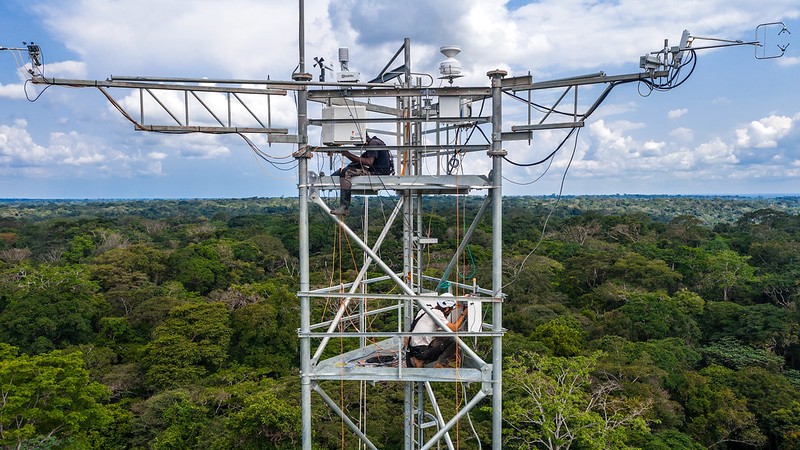
How can this information help in the fight against climate change?
“A flux tower helps us better estimate how much CO₂ a tropical forest is able to capture annually. And how this level evolves. We already know that with nature alone – a CO₂-capturing rainforest – we will never win the battle against climate change. It will only be won through daring political decisions.”
The first tower is in the Congolese rainforest. Why is that location so special
“You’ll find that there are more than a thousand similar climate towers worldwide. For example, in the Amazon rainforest, there are about 15 of them. But in the Congo Basin rainforest, there were none, even though it is the second largest contiguous tropical forest in the whole world after the Amazon. It meant there was a huge gap in our knowledge about the exchange of CO₂ between the rainforest and the atmosphere."
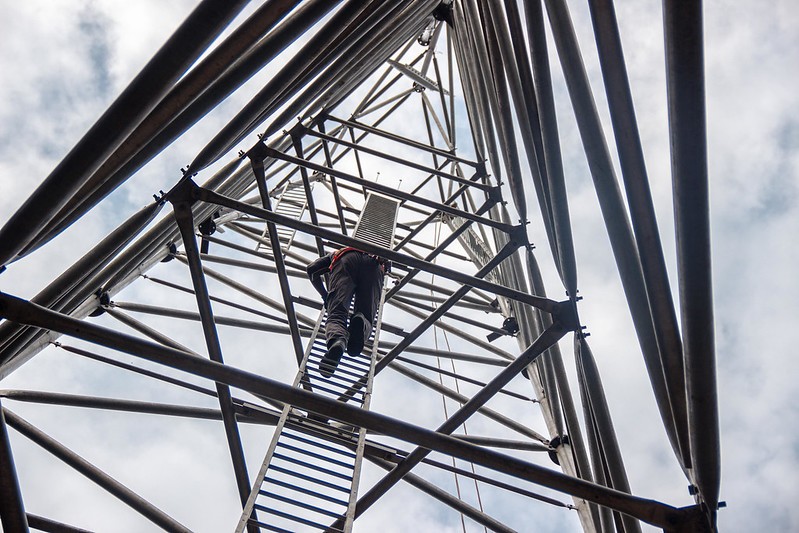
Are you able to monitor all the measurements from Gent?
“Every night at 1 am, the results from the previous day are automatically transmitted to Ghent. At the same time, they are stored on hard disks and memory cards at the tower itself as a backup measure. A Congolese technician visits the site every week to check all the instruments and sensors. He also climbs the 57-metre-high tower to collect all the data. In this way, we cover all possible risks. One of our technicians keeps an eye on the tower from Ghent. In addition, a number of doctoral students carry out scientific research based on the data from our flux tower.”
Why is the tower so high?
“The trees in a tropical forest are gigantic: the forest canopy, or top layer, is about 35 metres high. Our tower rises to about 20 metres above that. On a grassy plain, you wouldn’t need to build such an immense tower. Quite simply, the higher the flux tower rises above the forest canopy, the larger the area we can measure with the sensors.”
The tower was built in 2020, in the middle of the corona crisis. That must have been a challenge
“Yes, it was difficult at times. The components of the tower were put into six containers and sent by ship from Antwerp to Mombasa, Kenya in January 2020. From there, three trucks took them in convoy to Congo via Uganda. The day the whole world went into lockdown, our trucks were lined up at the border crossing between Uganda and Congo. Two trucks had just crossed when the border was closed. Our third truck was slightly delayed as the border guards saw their chance to earn a little extra cash. Negotiations would have been tough!
From Kisangani, the containers were put on a pontoon that sailed 100 kilometres up the Congo River. Congolese constructors then built the tower without a crane. It was remarkable. They pulled up 5-metre-long components each time. In October 2020, we installed the first equipment.”
Where does the tower get its energy from?
“From the sun. At the same time we put the tower up, we also installed a vast solar park with eighty solar panels. We built it in an existing clearing, a few kilometres outside the forest. We didn’t cut down a single tree. Eighty solar panels does seem a lot to provide electricity for just the tower, but we plan to install other metering equipment in the future. We also added emergency solar panels to the tower. The fact is there has already been a lightning strike once; in the rainforest, back-up solar panels are not a luxury!”
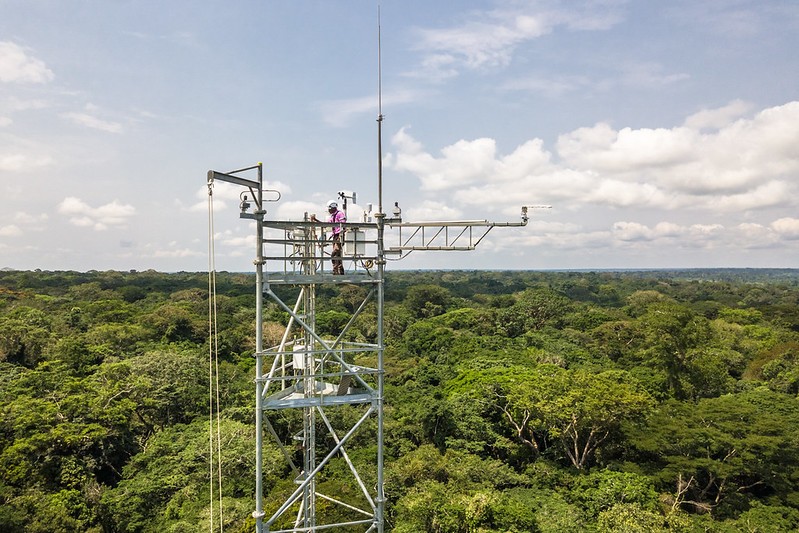
Is it too early for definitive results?
“Yes it is, but we have been taking other measurements from the region for a while. The temperature has been registered in detail every day since 1960, so we know that it has risen by one degree over the past sixty years. The difference between 25 and 26 degrees may not seem very much at first glance. But we have also seen that there has been an increase in the number of extremely warm days, with a temperature of over 32 degrees. The level of rainfall has stayed fairly constant, but these days the rainstorms themselves are heavier than ever before.”
Is that not a cause for concern?
“The tropical rainforest here is important not just because of its capacity to store CO2, but also for the water cycle in Congo and neighbouring countries, including Ethiopia and South Sudan. The water that evaporates via the forest drives the rainfall in that part of Africa. Our biggest concern is that at a certain point, we are going to arrive at a pivotal moment, or ‘tipping point’. If the temperature rises above 32 degrees, then photosynthesis in the leaves will reduce dramatically, and there will be less water evaporation. Today the rainforest is green all year round, but an increase in temperature could result in the trees losing their leaves in the dry season. And if that happens, then the way the whole ecosystem functions will change completely.”
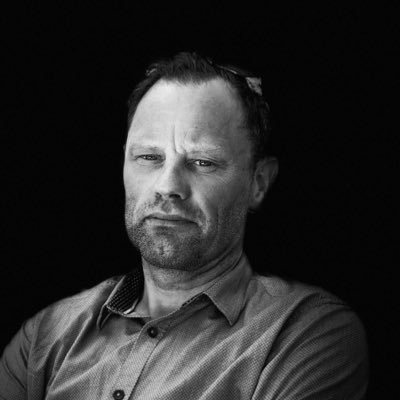
Pascal Boeckx is a Professor in the Department of Green Chemistry and Technology, which is part of the Faculty of Bioscience Engineering. Since last year his name has been included in the Reuters Hot List, a list of the most influential climate scientists.
Read also
Understanding the impact of climate change? Measure, measure and measure again!
“Climate change is a global problem. But if you really want to know its impact, you have to have local data.” So say meteorologist Steven Caluwaerts and bioengineer Pieter De Frenne. They both do research on microclimates, albeit with a different starting point. “Actually, we are very complementary. We should meet more often!”
Student Helena participated in world's largest climate summit
Helena Van Tichelen was in secondary school when the school strikes and marches around climate change erupted. Years later, she has not lost the commitment she picked up then. In mid-November, she put aside the lessons and courses of her third bachelor in bioengineering to travel to Egypt for the largest climate conference in the world: COP27.
Ghent University developing the climate-adaptive forest of the future
The last years’ drought has caused stress in trees. Some have stopped growing; others have shed their foliage. Sometimes entire forests have perished. The bioengineers at the Department of Environment (Faculty of Bioscience Engineering) are crossing national borders to try to find out the causes of the problems effecting trees globally and working on a type of forest that can cope with climate change.
Could smart clothing keep us cool in tropical temperatures?
Will we soon be wearing smart textiles that can adapt to the heat? Professor Lieva Van Langenhove of the Department of Materials, Textiles and Chemical Process Engineering explains how that could work.
